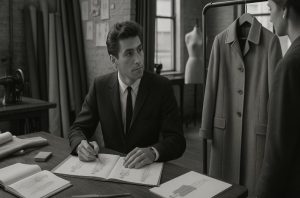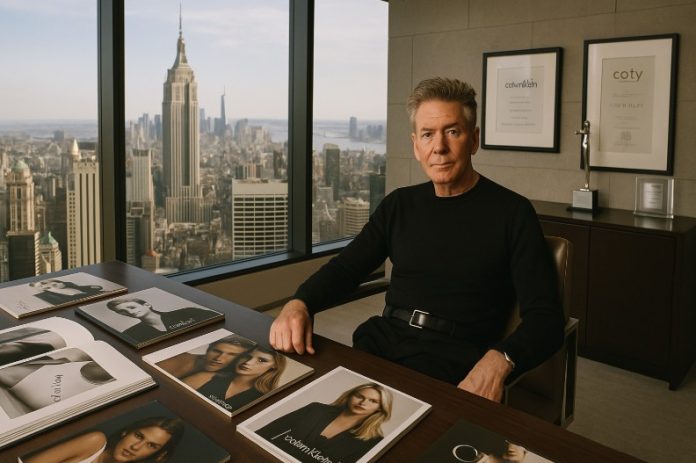Table of Contents
Calvin Klein is one of the most influential figures in the global fashion industry. Known for his minimalist style and bold marketing strategies, he transformed his name into a globally recognised brand.
From launching iconic denim lines to revolutionising underwear and fragrance advertising, Klein’s business acumen is as notable as his designs.
This article explores Calvin Klein’s current net worth, the journey behind his fashion empire, and the investments that have helped sustain his financial legacy.
Who Is Calvin Klein?

Calvin Richard Klein is a renowned American fashion designer, widely credited for reshaping modern fashion through his minimalist aesthetic and bold marketing strategies.
Born on November 19, 1942, in the Bronx, New York City, Klein emerged as one of the most influential figures in the global fashion industry.
He launched Calvin Klein Inc. in 1968 alongside his childhood friend Barry K. Schwartz, a move that marked the beginning of a brand that would become synonymous with clean lines, luxury basics, and provocative advertising.
Klein’s design philosophy stood out in a crowded market for its simplicity, refinement, and urban elegance.
He was heavily influenced by his upbringing in a Jewish immigrant neighbourhood that also produced design legends like Ralph Lauren.
His early education at the High School of Art and Design and the Fashion Institute of Technology (FIT) laid the foundation for his creative development, although he left FIT before completing his degree.
His career began with an apprenticeship at a New York City cloak-and-suit manufacturer, where he gained essential hands-on experience.
This practical knowledge, combined with his vision, led to rapid recognition including being hailed as “the new Yves Saint Laurent” after his first major showing at New York Fashion Week.
Klein revolutionised American fashion not only through design but also through branding. His 1974 denim launch was a commercial success, with jeans grossing $200,000 in the first week. He later expanded into underwear, fragrances, watches, and accessories, building a lifestyle empire.
Calvin Klein: Profile Summary
| Attribute | Details |
| Full Name | Calvin Richard Klein |
| Date of Birth | November 19, 1942 (age 83) |
| Place of Birth | Bronx, New York City, United States |
| Education | High School of Art and Design; Fashion Institute of Technology |
| Occupation | Fashion Designer |
| Fashion Label | Calvin Klein Inc. |
| Spouses | Jayne Centre (1965–1974), Kelly Rector (1986–2006) |
| Partner | Kevin Baker (2016–present) |
| Children | Marci Klein (television producer) |
Throughout his career, Klein has received numerous accolades, including multiple CFDA Awards, a Golden Plate Award from the American Academy of Achievement, and an honorary doctorate from FIT.
His influence extends beyond fashion; he is also known for supporting the Democratic Party, donating over $250,000 to political campaigns.
Outside of fashion, Klein has made headlines for his high-profile relationships and impressive property portfolio, which includes multi-million-pound homes in New York, Miami, and Los Angeles.
His legacy continues to shape the fashion landscape today, with the Calvin Klein brand remaining one of the most recognisable names in the world.
What Is Calvin Klein’s Current Net Worth in 2025?
As of 2025, Calvin Klein’s net worth is estimated to be approximately $800 million (£630 million).
Though he no longer controls the brand he founded, his personal fortune continues to grow through structured royalties, strategic licensing deals, and significant real estate investments.
This financial success reflects not only his impact as a designer but also his acumen as a businessman who capitalised on his brand at its peak.
Net Worth Breakdown (2025 Estimates)
The following table outlines the estimated composition of Calvin Klein’s net worth in 2025:
| Asset Category | Estimated Value (USD) | Description |
| Brand Sale Royalties & Bonuses | $200 million | Earned from PVH Corp. since the 2003 acquisition |
| Licensing Income | $150 million | Ongoing earnings from global product licensing |
| Real Estate Holdings | $300 million | Properties in NYC, LA, the Hamptons |
| Investment Portfolio | $100 million | Stocks, private equity, and other long-term investments |
| Cash and Liquid Assets | $50 million | Bank accounts, short-term holdings |
| Total Net Worth | $800 million | As of 2025 |
This figure places Calvin Klein among the most financially successful fashion designers in the world, although not at the billionaire level of Giorgio Armani or Ralph Lauren.
Comparison to Previous Years
Klein’s net worth has remained relatively stable over the past decade, thanks to consistent royalty payments and substantial real estate transactions.
While he is no longer an active business operator, his legacy contracts and investment strategy have preserved his financial standing.
| Year | Estimated Net Worth (USD) | Key Financial Event |
| 2003 | $500 million | Sale of Calvin Klein Inc. to PVH Corp. |
| 2010 | $600 million | Increased value from fragrance and apparel lines |
| 2020 | $750 million | Profitable real estate appreciation |
| 2025 | $800 million | Growth from passive income and asset diversification |
Key Factors Influencing His Net Worth
A number of well-managed revenue channels contribute to Calvin Klein’s financial success:
1. Brand Sale to PVH Corp.
In 2003, Calvin Klein sold his company to Phillips-Van Heusen (PVH Corp.), one of the largest apparel companies in the world. The deal was structured to ensure that Klein would continue to earn money through future brand performance, including:
- $400 million upfront payment
- $30 million in PVH stock
- Up to $300 million in potential performance-based royalties
This agreement has ensured steady royalty income even two decades later.
2. Licensing and Endorsement Deals
Despite selling the brand, Calvin Klein continues to benefit financially from licensing agreements associated with:
- Fragrances (especially CK One, Obsession, Eternity)
- Eyewear and accessories
- Bedding and homeware collections
- Global clothing distribution
His licensing strategy allowed the brand to scale globally, generating substantial passive income.
3. Real Estate Holdings
Klein has built a remarkable property portfolio across high-value locations. Over the years, he has bought, renovated, and sold several luxury properties, many of which appreciated significantly. His holdings include properties in:
- East Hampton
- Southampton
- West Village, New York City
- Los Angeles, California
The sale of his East Hampton estate for $85 million in 2021 alone contributed a major boost to his personal wealth.
4. Investments and Other Income
Aside from brand-related income, Calvin Klein has also invested in stocks, bonds, and private equity. While he keeps these investments largely private, industry insiders suggest they form a modest but consistent part of his net worth.
How Did Calvin Klein Start His Fashion Career?

Calvin Klein, born in 1942 in the Bronx, New York, was raised in a family that encouraged artistic expression. His grandmother, a seamstress, played a critical role in inspiring his love for sewing and design.
While most children were focused on sports, Klein was sketching dresses and learning garment construction.
His educational background in fashion included the High School of Art and Design, followed by enrolment at the Fashion Institute of Technology (FIT).
Although he didn’t complete his studies, his early talent was undeniable. FIT later awarded him an honorary Doctorate in 2003 for his contributions to the industry.
In 1962, Klein began his professional journey as an apprentice at a suit manufacturer in New York.
After several years working for others, he co-founded Calvin Klein Inc. in 1968 with Barry Schwartz.
While Klein handled the creative direction, Schwartz took control of business operations, forming a balanced and effective partnership that would prove crucial to the brand’s success.
What Made Calvin Klein, Inc. So Successful?
Calvin Klein Inc. gained its reputation by combining minimalist aesthetics with high-quality tailoring. The brand initially focused on coats, suits, and casual wear for women, and then expanded into broader lifestyle categories.
Some pivotal milestones in the brand’s early growth include:
- A breakthrough order from department store Bonwit Teller after a buyer accidentally visited Klein’s showroom
- Strategic coverage in top-tier fashion magazines such as Vogue and Harper’s Bazaar
- Product diversification into denim, lingerie, and casual wear
The company’s first big expansion came in the 1970s with the launch of Calvin Klein Jeans, which quickly became a commercial and cultural success.
In 1982, the introduction of Calvin Klein Underwear created an entirely new category within men’s and women’s fashion. The brand’s growth strategy leaned heavily into:
- Premium positioning with affordable pricing
- Expansion into international markets
- Product lines across fragrance, eyewear, swimwear, and homeware
This approach helped Calvin Klein Inc. evolve into a global brand with multi-billion-pound value.
How Did Calvin Klein Use Marketing to Build His Empire?
Marketing has always been at the heart of Calvin Klein’s business strategy. The brand is known for its ability to provoke attention while maintaining an aura of sophistication.
One of the most talked-about campaigns in fashion history featured a young Brooke Shields with the slogan, “Nothing comes between me and my Calvins.” This tagline launched Calvin Klein Jeans into mainstream pop culture and redefined how fashion brands used celebrity endorsements.
Throughout the 1980s and 1990s, Klein continued to push the envelope through his fragrance and underwear campaigns. The advertisements were marked by:
- Provocative imagery designed to evoke strong public reaction
- Collaborations with cultural icons such as Mark Wahlberg and Kate Moss
- Visual storytelling that emphasised youth, rebellion, and sensuality
While many of these campaigns attracted criticism — including from U.S. political leaders such as President Bill Clinton and First Lady Hillary Clinton — they also drove massive commercial returns. Several ads were even banned from television, but the resulting media attention only fuelled the brand’s popularity.
The marketing campaigns for fragrances like Obsession, CK One, and Eternity introduced a more unfiltered, raw portrayal of beauty, challenging the status quo of overly polished models. These campaigns positioned Calvin Klein as a voice for authenticity and modern identity in fashion.
What Business Moves Increased Calvin Klein’s Net Worth?
Calvin Klein’s wealth surged significantly following the sale of his company to Phillips-Van Heusen (PVH) in 2003. This business transaction was structured to include:
| Element of Sale | Value |
| Cash Payment | $400 million |
| PVH Stock | $30 million |
| Potential Royalties & Bonuses | Up to $300 million |
The deal ensured Klein a significant upfront sum while allowing him to benefit from the future success of the brand through performance-based incentives. This structure is considered one of the most successful brand exits in the fashion industry.
Klein also generated income through extensive licensing agreements, which allowed third parties to manufacture and sell products under the Calvin Klein brand. These included:
- Fragrances (in partnership with Coty Inc.)
- Eyewear and accessories
- Home goods and bedding collections
In addition to brand-related earnings, Klein significantly grew his fortune through property investments. Several of these purchases turned into massive financial wins, as illustrated below.
How Has Calvin Klein Invested His Wealth?
Real estate has been a vital component of Calvin Klein’s financial portfolio. Known for purchasing, renovating, and reselling luxury properties, he has generated substantial profits over the years.
| Property Location | Purchase Price | Sale Price | Notes |
| East Hampton | $3.6 million | $85 million (2021) | Historic mansion; sold to private buyer |
| Southampton | $30 million | $84 million (2020) | Demolished and rebuilt with a modern mansion |
| West Village, New York | $14 million | Not listed | 12,000 sq ft penthouse on three levels |
| Hollywood Hills, L.A. | $25 million | Not listed | Ultra-modern estate with panoramic views |
Each of these transactions demonstrates Calvin Klein’s keen eye for valuable assets and market timing. The resale values of his properties often reflected multi-fold returns on his original investments.
What Awards and Recognition Has Calvin Klein Received?
Calvin Klein has earned widespread recognition throughout his career, cementing his reputation as a fashion trailblazer. His awards include:
- Three Coty Awards, an early fashion accolade that celebrated innovation in American fashion
- Council of Fashion Designers of America (CFDA) Awards in 1982, 1983, 1986, and 1993
These honours underscore his lasting impact on American style and his ability to consistently deliver visionary design. In addition to formal awards, his presence in pop culture further elevated his status. He made a cameo appearance in the TV series 30 Rock and was fictionalised in an episode of Seinfeld.
Such references reflect not only his influence within the fashion world but also his broader cultural relevance.
What Do We Know About Calvin Klein’s Personal Life?

Calvin Klein’s personal life has been a mixture of public relationships and private battles. He married Jayne Centre in 1964, with whom he had a daughter, Marci Klein, now a successful television producer.
After their divorce in 1974, he later married his assistant, Kelly Rector, in 1986. That marriage lasted until 2006, though they separated a decade earlier.
Klein has openly discussed having romantic relationships with both men and women, though he has refrained from aligning with any specific label regarding his sexuality. One of his more public relationships was with model Nick Gruber.
He has also struggled with substance addiction, entering rehab programmes in both the late 1980s and early 2000s.
These experiences coincided with major transitions in his business life, including the eventual sale of his company.
Politically, Calvin Klein is a known supporter of the Democratic Party, making regular contributions to political campaigns and progressive causes.
His involvement in philanthropy and political discourse has further enhanced his public image as a thoughtful and culturally engaged figure.
How Does Calvin Klein’s Net Worth Compare With Other Fashion Icons?
While Calvin Klein’s wealth is substantial, it does not reach the levels of some of his contemporaries. The table below illustrates how he compares:
| Fashion Designer | Estimated Net Worth (2025) | Brand Status | Nationality |
| Giorgio Armani | £7.5 billion | Founder, Armani Group | Italian |
| Ralph Lauren | £5.6 billion | Founder, Ralph Lauren Corp. | American |
| Tom Ford | £1.5 billion | Brand sold to Estée Lauder | American |
| Calvin Klein | £630 million | Brand sold to PVH | American |
| Vera Wang | £510 million | Active under licensing model | American |
Although Calvin Klein does not lead in financial rankings, his legacy remains foundational to the evolution of modern fashion branding, particularly in how minimalism and sexuality were woven into mainstream marketing strategies.
Conclusion
Calvin Klein’s impressive net worth reflects decades of innovation, calculated risk-taking, and an acute understanding of consumer culture.
While he may no longer lead his brand, the empire he built continues to thrive under global ownership.
His strategic brand exit, combined with lucrative licensing and real estate investments, has secured his place among fashion’s most financially successful names.
Klein’s legacy remains deeply embedded in the fashion industry, setting a standard for how creativity and commerce can coexist successfully.
FAQs About Calvin Klein’s Net Worth and Career
What are Calvin Klein’s most profitable product lines?
His most profitable lines include underwear, fragrances (like Obsession and Eternity), and denim, particularly during the peak of the brand’s popularity in the 1980s and 1990s.
Did Calvin Klein retire completely from fashion?
Yes, Klein stepped back after selling his company in 2003 and has not returned to active design roles since. However, his legacy continues under the ownership of PVH Corp.
How did Calvin Klein influence fashion advertising?
He pioneered bold, often controversial campaigns that challenged social norms and redefined how fashion brands communicate with audiences.
Is Calvin Klein still involved in business decisions?
No, after selling his brand, he distanced himself from operations and now leads a more private life, focusing on philanthropy and personal investments.
Has Calvin Klein ever been on the Forbes billionaire list?
No, while immensely wealthy, his net worth has not surpassed the $1 billion threshold required for the Forbes billionaire ranking.
Where is Calvin Klein living now?
Klein divides his time between New York and Los Angeles, maintaining several high-value properties.
What is Calvin Klein’s influence on modern fashion brands?
Many contemporary brands adopt his minimalist design principles and bold marketing techniques. His approach laid the groundwork for modern fashion branding strategies.


